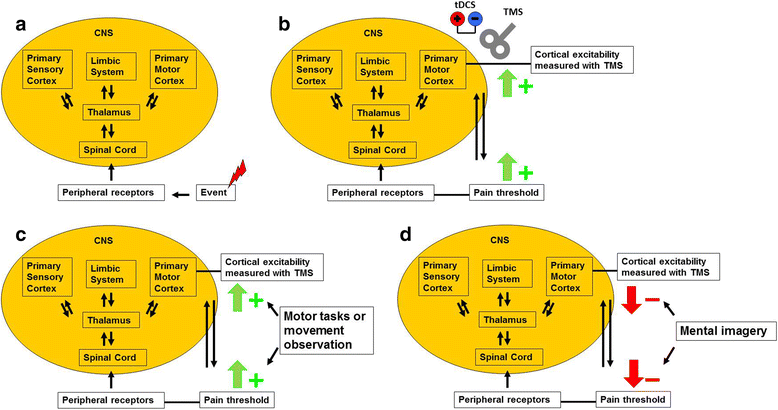Mental imagery-induced attention modulates pain perception and cortical excitability
- PMID: 25887060
- PMCID: PMC4387598
- DOI: 10.1186/s12868-015-0146-6
Mental imagery-induced attention modulates pain perception and cortical excitability
Abstract
Background: Mental imagery is a powerful method of altering brain activity and behavioral outcomes, such as performance of cognition and motor skills. Further, attention and distraction can modulate pain-related neuronal networks and the perception of pain. This exploratory study examined the effects of mental imagery-induced attention on pressure pain threshold and cortical plasticity using transcranial magnetic stimulation (TMS). This blinded, randomized, and parallel-design trial comprised 30 healthy right-handed male subjects. Exploratory statistical analyses were performed using ANOVA and t-tests for pain and TMS assessments. Pearson's correlation was used to analyze the association between changes in pain threshold and cortical excitability.
Results: In the analysis of pain outcomes, there was no significant interaction effect on pain between group versus time. In an exploratory analysis, we only observed a significant effect of group for the targeted left hand (ANOVA with pain threshold as the dependent variable and time and group as independent variables). Although there was only a within-group effect of mental imagery on pain, further analyses showed a significant positive correlation of changes in pain threshold and cortical excitability (motor-evoked potentials via TMS).
Conclusions: Mental imagery has a minor effect on pain modulation in healthy subjects. Its effects appear to differ compared with chronic pain, leading to a small decrease in pain threshold. Assessments of cortical excitability confirmed that these effects are related to the modulation of pain-related cortical circuits. These exploratory findings suggest that neuronal plasticity is influenced by pain and that the mental imagery effects on pain depend on the state of central sensitization.
Figures





References
Publication types
MeSH terms
Grants and funding
LinkOut - more resources
Full Text Sources
Other Literature Sources
Medical

